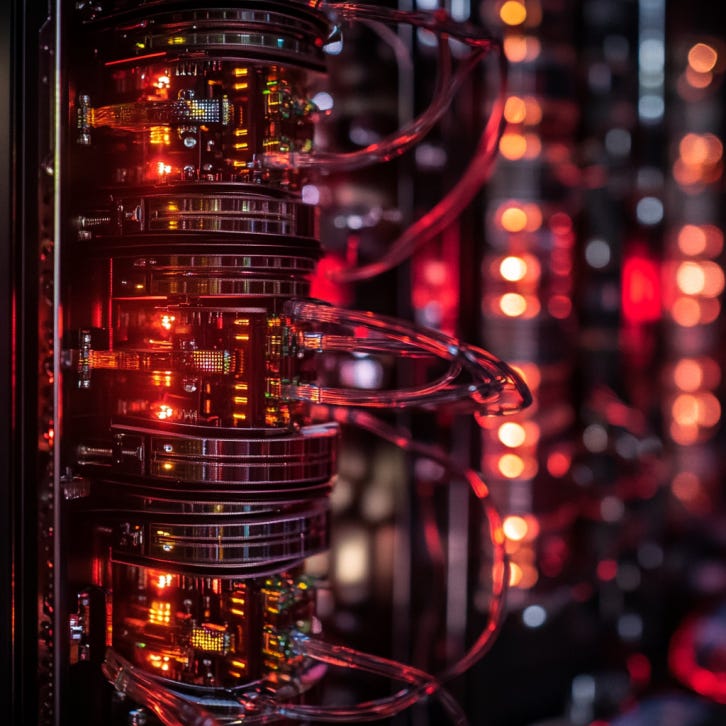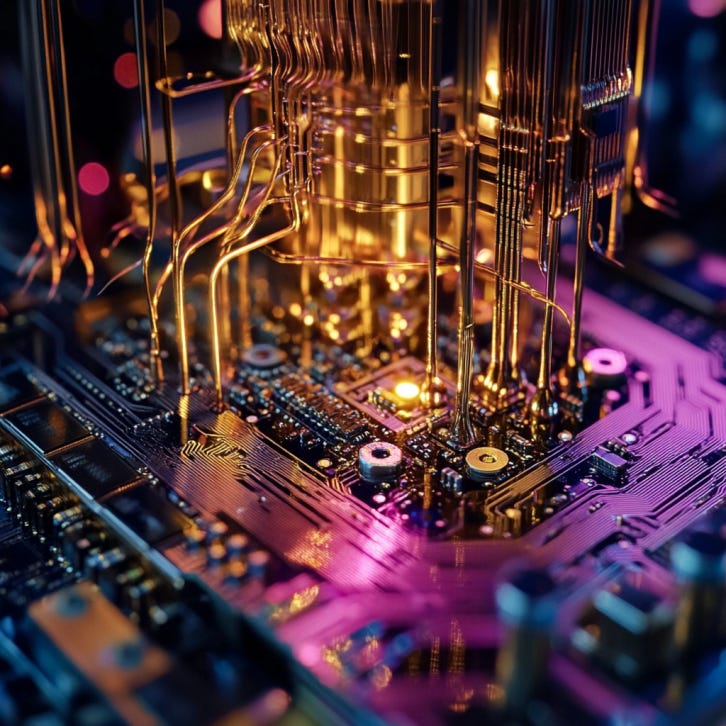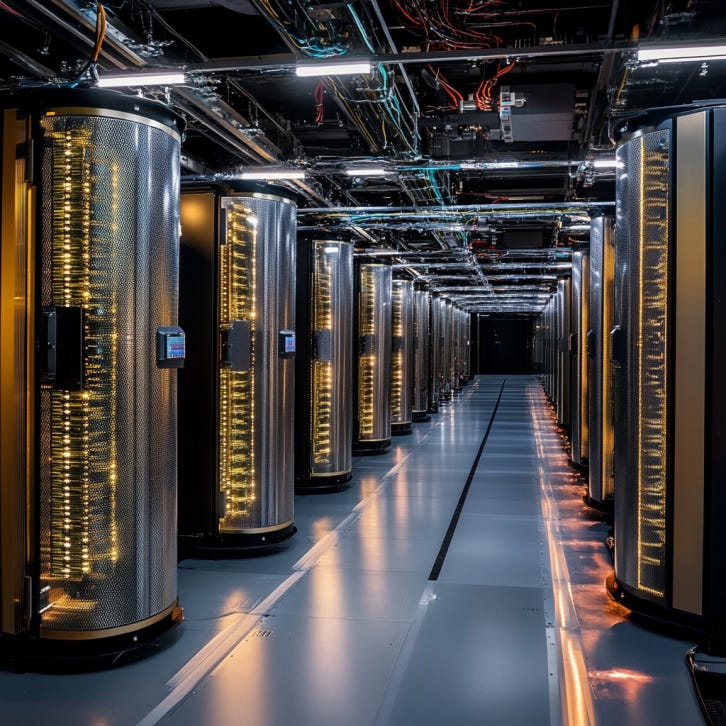4 Overvalued Quantum Computing Stocks (2025): QUBT, QBTS, RGTI, IONQ - Short Strategy & Analysis
As of January 2025, pure-play quantum computing stocks; QUBT, QBTS, RGTI, IONQ are in "bubble" territory and could be reasonable candidates for short positions
The current investing climate is a high-stakes game driven by macroeconomic trends and a surge of enthusiasm for AI and other cutting-edge technologies.
In this environment, quantum computing stocks—tied to a still-nascent industry—have attracted attention from investors looking for the “next big thing.”
I’ve already written about why “Quantum Computing Stocks are in a Massive Hype Bubble (2025).”
In this piece I’m going to further evaluate the 4 major quantum computing pure-play stocks and present a short strategy that one could consider implementing if they fully understand the risks and agree with the bubble thesis.
The Macro & “AI-Mania” Environment
Risk-On Climate
Fed Rates: 4–5% range, but liquidity remains high, and credit spreads are tight.
High Growth Tech Bubble?: The NASDAQ and growth-oriented stocks have soared, partly on AI enthusiasm. Even companies with solid fundamentals (e.g., Tesla, Palantir) trade at lofty multiples. Investors often rotate into “frontier” themes like quantum, photonics, neuromorphic, etc.
FOMO Dynamics
Many portfolio managers and retail traders chase the “next big thing,” hoping quantum becomes the next NVIDIA.
As long as the market stays in a “risk-on” posture, these overhyped quantum names could remain elevated—one reason shorting them can be risky even if the fundamental analysis says they are massively overpriced.
Downside If Macro Turns
If inflation resurges or the Fed tightens further, these long-duration, unprofitable tech plays tend to crash first and hardest.
Investors might finally focus on cash flow and near-term revenue, realizing quantum computing is still mostly in R&D.
The Case for a Quantum Computing Bubble
Classic Bubble Indicators
Sky-High Valuations with Minimal Revenue: 100×, 200×, even 1,000× forward P/S multiples.
Retail Speculation: Social media hype, confusion about “quantum = advanced AI.”
Industry Experts’ Skepticism: Many respected figures (e.g., Huang) see mainstream quantum usage as 15–20 years away, not 2–3 years.
Near-Zero Real-World Use: Most “deals” are tiny pilot or government grants for exploration.
Comparisons to Past Hype Cycles
Dot-Com: In the late 1990s, companies with no revenue soared on future “internet” potential.
3D Printing: Valuations skyrocketed in 2013, only to collapse when growth lagged hype.
SPAC Boom: Many pre-revenue EV/hydrogen companies soared before crashing.
Quantum’s run from 2024–2025 fits the same pattern: big announcements + minimal revenue + massive stock surges.
4 Quantum Computing Stocks in Bubble Valuations (Jan 2025)
These 4 pure-play quantum computing stocks frequently appear at the center of the ongoing “quantum bubble” discussion due to astronomical valuations, minimal revenue, and a timeline for commercial quantum computing that may be 10–20+ years away.
1. Quantum Computing Inc. (QUBT)
Background & Technology
Founded: 2018; pivoted in 2022 with the acquisition of QPhoton to focus on photonic quantum computing.
Core Tech: Photonic-based “quantum processing units” (QPUs). The company claims to produce thin-film lithium niobate (TFLN) chips for on-chip photonic circuits.
Stage: Extremely early. Much of the work remains R&D or pilot-phase foundry services. No widely recognized gate-model or large-scale photonic quantum system is deployed.
Key Financials & Valuation
Annual Revenue: Under $1 million—essentially negligible.
Market Cap: Spiked above $1 billion during the 2024 quantum mania. Even after a significant sell-off in early 2025, it remains far above any conventional fundamental justification.
Forward P/S Ratio: Previously ~1,800; even a 50%–60% crash leaves it in the hundreds or thousands—astronomically high by any standard.
Cash Burn: Estimated $10M–$20M per year. The company has relied heavily on equity raises to fund R&D and cover operating expenses.
Current Commercial Status
Pilot “Foundry” Deals: Management has mentioned a handful of pilot orders—typically small R&D or university collaborations. These are often worth low six figures at best.
No Large-Scale Contracts: QUBT has not announced any multi-million-dollar enterprise deals.
Cloud Integration: Not listed on AWS Braket, Azure Quantum, or other major quantum-as-a-service platforms—limiting developer adoption and real-world usage.
Why It’s Overvalued
Revenue Mismatch: Earning under $1M while commanding a market cap north of $1B is one of the most glaring disparities in the quantum space.
Extreme Multiples: Even post-sell-off, forward price-to-sales is still off the charts.
Early R&D Stage: Photonic quantum computing is promising but remains at the “far frontier,” with well-funded private ventures (e.g., PsiQuantum, Xanadu) arguably much further ahead.
Hype-Driven: QUBT soared over 2,000% in 2024 on hype alone—very little fundamental news supported that rise.
Short Thesis & Risks
Short Rationale:
Negligible revenue, enormous valuation gap, and uncertain R&D roadmap.
Photonic quantum computing is complex, and QUBT is a small player in a space filled with stronger competitors.
Risks:
Low float can trigger violent short squeezes if retail traders or hype re-emerges.
Even a modest “we shipped a chip” press release could temporarily spike the stock price.
Timing is unpredictable in a risk-on market.
2. D-Wave Quantum (QBTS)
Background & Technology
Founded: 1999 in Canada; the world’s first commercial quantum computing company to release systems for sale.
Core Tech: Quantum annealing machines (e.g., Advantage system with 5,000+ qubits). Recently started R&D on gate-model quantum as well, though it’s at a nascent stage.
Quantum Annealing: Useful for certain optimization problems, but not universal. Many in the industry view annealing as a niche approach compared to gate-model architectures (IonQ, Rigetti, IBM, Google).
Key Financials & Valuation
Annual Revenue: Under $10 million, despite operating for ~25 years. Growth has often been flat or single-digit.
Market Cap: Surged from about $100 million to over $1–$2 billion after a SPAC merger and a wave of quantum hype in 2024. Fell ~50% post-Jensen Huang remarks but still significantly above pre-hype levels.
Forward P/S & EV/Sales: Often well above 100, extremely high for a slow-growing company.
Cash Burn: Tens of millions per year, repeatedly raising capital to fund operations.
Current Commercial Status
Small, R&D-Focused Contracts: Provides quantum annealing via its cloud service (QCaaS). Has sporadic deals with government agencies and large enterprises for pilot-level optimization tests.
Lacks Significant Enterprise Scale: After more than two decades, D-Wave has yet to land broad, large-scale enterprise deployments.
Gate-Model Program: Newly launched but well behind the top gate-model players (IBM, Google, IonQ).
Why It’s Overvalued
Long History, Minimal Traction: 25+ years in existence yet consistently under $10M in annual revenue.
Niche Technology: Annealing is powerful for specific optimization tasks, but it doesn’t address the broader HPC or AI markets.
Valuation vs. Growth: A P/S over 100 for single-digit revenue growth is unsustainable in nearly any tech sector.
Competitive Threats: Gate-model quantum systems—IBM, Google, IonQ—could overshadow D-Wave if/when universal machines become more viable.
Short Thesis & Risks
Short Rationale:
Persistent struggle to grow revenue; overhyped after the Google “Willow” announcement.
Annealing’s limited scope does not justify a multi-billion-dollar valuation.
Risks:
D-Wave’s brand recognition in quantum is relatively high, and any “gate-model” progress PR might spark a short-term rally.
It has survived many “down cycles” in quantum interest; optimism often reappears after any mild technical milestone.
3. Rigetti Computing (RGTI)
Background & Technology
Founded: 2013 by Chad Rigetti, a former IBM quantum researcher.
Core Tech: Superconducting qubits (transmon architecture), the same general approach used by Google and IBM.
In-House Fab: Rigetti built a small quantum chip fab (“Fab-1”), aiming for vertical integration. This differentiates them from IonQ, which largely partners with external fabs.
Key Financials & Valuation
Annual Revenue: Around $12–$13 million, which recently declined YoY.
Market Cap: Exceeded $2 billion at its peak (late 2024), after a ~1,500% surge. Pulled back about 40–50%, but still richly valued.
Forward P/S: Roughly 190–200—extraordinarily high for a company with shrinking revenue.
Cash Burn: Generally tens of millions per year. Often reliant on new equity offerings.
Current Commercial Status
DARPA/Government Contracts: Small R&D grants—these can run $1–$2 million. Helpful for technology development but nowhere near what’s needed to sustain a multi-billion-dollar valuation.
Cloud Offerings: Rigetti chips are available on AWS Braket, but the usage/adoption figures are not publicly disclosed.
Technical Roadmap: Targeting 80+ qubit systems (Ankaa-3, etc.) but lags Google, IBM, and possibly others in fidelity and scale.
Why It’s Overvalued
Declining Revenue, Triple-Digit P/S: Negative revenue growth plus a forward PS near 200 is an enormous red flag.
Competition: Overwhelming competition from IBM, Google (both superconducting heavyweights), and IonQ (arguably further along in real-world performance).
Management Turnover: Founder and CEO Chad Rigetti stepped down, creating uncertainty about technical and strategic direction.
Hype Spike: Much of Rigetti’s 2024 rally was attributed to a general quantum mania triggered by Google’s “Willow” news, not by Rigetti’s own breakthroughs.
Short Thesis & Risks
Short Rationale:
Weak revenue trajectory amid fierce competition.
Superconducting approach is capital-intensive, and Rigetti is overshadowed by far larger R&D budgets (IBM/Google).
Risks:
Any milestone announcing improved qubit fidelity or a big government contract could spark a surge.
Retail/meme traders can push the stock to irrational highs on superficial “quantum leap” headlines.
4. IonQ (IONQ)
Note: IonQ is often considered the “best in class” among small-cap quantum stocks due to its stronger technology position and higher revenue. However, it can still be overvalued in terms of near-term fundamentals.
Background & Technology
Founded: 2015, spun out of research from the University of Maryland and Duke University.
Core Tech: Trapped-ion qubits, which tend to have longer coherence times and higher fidelity than many superconducting systems—albeit with different scaling challenges.
Positioning: IonQ machines are accessible on AWS, Azure, and Google Cloud. The company has formed notable industry partnerships (Airbus, Hyundai, etc.).
Key Financials & Valuation
Annual Revenue: Forecast of $38–$42 million for 2024—highest among the pure-play quantum group.
Market Cap: Hit $6–$7 billion at its peak; pulled back ~30–45% after Jensen Huang’s remarks. Still well above $4B in some estimates.
Forward P/S & EV/Sales: Ranged from 150–300 at different points—enormously high, but less extreme than QUBT, Rigetti, or D-Wave.
Cash Burn: Likely $50M–$100M+ per year. IonQ has been aggressive in expanding R&D and forming partnerships.
Current Commercial Status
Pilot Projects: Partnerships in automotive (Hyundai), aerospace (Airbus), and financial modeling. Real revenue is being generated, though still modest in absolute terms.
Technical Roadmap: IonQ claims to have a path toward more qubits (e.g., 29–32 qubits with high fidelity), with 64–100 qubits targeted in the next few years.
Most Credible Among Pure-Plays: IonQ’s technology is respected by quantum researchers; the data often shows higher fidelity vs. similarly sized superconducting devices.
Why It’s Overvalued
Still a Niche Market: Even with IonQ’s “leading” position, total annual revenue is well under $50M—far too small to justify a multi-billion-dollar cap in conventional terms.
Decades to Full Commercialization: Trapped-ion scaling is slow and still requires major breakthroughs to reach fault tolerance.
Expensive R&D: IonQ will need to continue raising capital or burning its cash reserves to scale up the hardware and software ecosystem.
Retail Optimism: IonQ is the “go-to” quantum stock for many retail investors, fueling a premium that may not align with near-term prospects.
Short Thesis & Risks
Short Rationale:
Even though IonQ is more credible, a forward P/S of 150+ is extraordinarily high by any normal standard.
The 15–20 year horizon for “very useful” quantum computing suggests current valuations remain inflated.
Risks:
IonQ is the strongest of the small pure-plays; if quantum matures faster than expected, IonQ might capture real revenue first.
Partnerships with major enterprises and cloud providers can create a steady drumbeat of positive news, keeping the share price aloft.
IonQ has more institutional interest (versus purely retail mania).
Ranking the “Bubble Factor” for Quantum Computing Stocks (Jan 2025)
1. QUBT (Quantum Computing Inc.)
Bubble Level: Extreme.
Under $1M in revenue, soared to $1B+ in valuation, 1,000+ forward P/S.
2. D-Wave Quantum (QBTS)
Bubble Level: Very High.
25-year track record, still under $10M in revenue; stuck in a niche.
3. Rigetti Computing (RGTI)
Bubble Level: Very High.
Declining revenue (~$12M), overshadowed by larger superconducting players, forward P/S ~200.
4. IonQ (IONQ)
Bubble Level: High but slightly less absurd.
Real revenue in the tens of millions, credible partnerships, but a forward P/S still in triple digits.
Recap: Quantum Computing Short Thesis (2025)
Overarching Bubble Dynamics
Macro Factor: We’re still in a risk-on environment with high liquidity, so speculative capital flows into “next big thing” tech.
Misconceptions: Retail investors incorrectly assume quantum will soon replace GPUs for AI or robotics. In reality, quantum will likely be an accelerator for specialized tasks—potentially decades away.
Hype Cycle: Triggered by Google’s “Willow” press release in late 2024, then cooled by Jensen Huang’s remarks at CES 2025. Yet valuations remain high.
Short Thesis Summary
High-Level Rationale: The gap between minimal revenue and multi-billion-dollar valuations is enormous, especially if quantum commercialization is 10–20+ years away.
Most Extreme: QUBT, D-Wave, Rigetti—limited real-world traction, stratospheric multiples. IonQ is “best in class” but still trades at inflated valuations.
Risks:
Bubbles can inflate longer than logic suggests.
Short squeezes, hype press releases, or new pilot announcements can cause temporary spikes.
If macro remains strongly risk-on, money can keep flowing into “story” stocks.
The 4 “Pure-Play” Quantum Targets
All 4 of these “pure-play” quantum names remain overvalued for near-term fundamentals. While the long-term potential of quantum computing is real, current valuations are pricing in a revolution that most experts say is at least a decade (and more realistically two decades) away.
QUBT is likely the most glaring case of hype with essentially zero real revenue.
D-Wave (QBTS) has a long history but minimal traction; it soared on near-pure speculation.
Rigetti (RGTI) boasts superconducting tech yet fails to gain meaningful revenue traction, overshadowed by IBM and Google.
IonQ (IONQ) is arguably the most legitimate of the four but still trades at breathtakingly high multiples compared to its modest revenue.
If you’re considering a short, you have strong fundamental logic—but be prepared to manage volatility, watch for hype spikes, and track the broader “risk-on/risk-off” environment that can keep bubble stocks afloat longer than many rational investors expect.
Shorting Quantum Computing Stocks (2025): Pros & Cons
Rationale
Fundamental Misalignment: If you believe it’s 10–20+ years before quantum sees major commercial uptake (something I believe), paying 200× forward sales is unsustainable.
Sector Correction Risk: If (or when) the broader market goes risk-off, quantum stocks could decline swiftly. (Unclear how macro will change.)
Risks & Considerations
High Volatility, Meme-Like Behavior: Small floats can lead to big squeezes if retail gets excited again.
Bubbles Can Last: As the saying goes, “the market can stay irrational longer than you can stay solvent.”
Fresh “Breakthrough” Headlines: Any new research PR—even if incremental—might pump share prices temporarily.
Timing Is Hard: A broad correction could come at any moment, or hype could continue if liquidity remains plentiful.
Looking Ahead: Is the Quantum Computing Hype Sustainable?
Potential for Future Booms & Busts
Quantum computing has real, long-term potential for breakthroughs in cryptography, materials science, and optimization.
As the technology matures, we may see additional hype cycles. Some big leaps or partial breakthroughs can reignite stock mania, even if practical usage is still years off.
Consolidation & Competition
Big Tech: Google, IBM, Microsoft, and Amazon all have quantum initiatives—often better-funded and more advanced than many small-caps.
Private Quantum Startups: Companies like PsiQuantum, Xanadu, ColdQuanta, and others remain private; they may overshadow the smaller public names if they achieve strong milestones.
Eventually, a “Shakeout”: Much like the dot-com era, many quantum startups could fold or be acquired. Only a handful might survive to become meaningful revenue-generating businesses.
Estimated “Odds” Each Will Be a Profitable Short & Typical Wait Times (2025)
Below is a rough estimate (based on somewhat of a subjective analysis) that each name will see a significant drop (50%+) from current levels over the next 6–12 months, plus an approximate time horizon.
Do not assume anything written here will actually happen and remember that 80% probability of a drop means 20% probability of no drop or gain.
Quantum Computing Inc. (QUBT)
Probability of a 50%+ drop: ~80%.
Timeframe: Could occur quickly (within 3–6 months) if quarterly updates show no real progress or if overall risk sentiment declines.
Rationale: Under $1M revenue with a $1B+ market cap is extreme. Any disappointment or market turn could deflate it rapidly.
D-Wave Quantum (QBTS)
Probability of a 50%+ drop: ~75%.
Timeframe: Possibly 6–9 months, needing a few more earnings cycles to confirm minimal revenue growth.
Rationale: 25+ years in operation, still under $10M revenue, recently soared. If the next 1–2 quarters fail to show traction, shares could sink further.
Rigetti Computing (RGTI)
Probability of a 50%+ drop: ~70%.
Timeframe: Likely 6–12 months. May take a couple of subpar earnings reports or capital-raise news.
Rationale: Declining revenue, overshadowed by big-tech superconducting efforts. A “business as usual” scenario likely sees the stock fade.
IonQ (IONQ)
Probability of a 40–60% drop: ~55–60%.
Timeframe: Possibly 9–15 months—IonQ might hold up better if it shows incremental revenue gains, but it’s still overvalued.
Rationale: IonQ actually has tens of millions in revenue, so the market might give them more leeway. Still, the valuation is extremely high if quantum remains years away.
Why a 6–12+ Month Window?
Earnings: Usually, it takes at least 2-3 quarters of disappointment to break the back of a hype story—especially if broader markets remain somewhat bullish.
Liquidity & Macro: If the Fed remains only mildly hawkish, these stocks might deflate slowly instead of crashing abruptly. However, a major “risk-off” event could accelerate the timeline.
Considerations if Short Quantum Stocks
Ultimately, shorting bubble tech requires both patience and discipline. Even if you’re convinced valuations are absurd, markets can remain irrational.
Unexpected Big Contracts: They’re unlikely but not impossible. A $5–$10M deal might seem trivial, but could still cause the stock to soar temporarily (especially for QUBT or D-Wave).
Market Timing: No strategy is perfect. Trying to top-tick the next rally is hard. The recommended approach is typically partial short now, partial short later to average in.
Odds & Wait: Shorting is never guaranteed, but given the fundamentals, the probabilities listed (~70–80% for QUBT, QBTS, RGTI, ~55–60% for IonQ) imply a good chance these plays will correct significantly over 6–12 months—barring truly game-changing developments. (You can come up with your own odds - do not assume mine are accurate.)
But with the valuations and timelines we see here, the risk/reward for these quantum shorts is arguably quite attractive, as long as you size positions carefully and maintain a realistic time horizon.
A Strategy to Short Quantum Computing Stocks (January 2025)
Disclaimer: Nothing here is financial or investment advice. I am not making any recommendations. Consult a financial and/or investment professional if you need help.
1. Basket Short with Weighted Allocation
Shorting a basket of these names in specific proportions helps spread out single-company risk (e.g., unexpected big contract). Here’s a suggested weighting:
QUBT: 35% (largest mismatch, minimal revenue)
QBTS: 25%
RGTI: 25%
IONQ: 15% (less extreme but still overvalued)
Why these weights?
Quantum Computing Inc. (QUBT) has the most blatant valuation gap (<$1M revenue vs. $1B market cap). This name has historically had some of the wildest “pop-and-drop” swings, offering potentially large downside if/when hype fades.
D-Wave Quantum (QBTS) and Rigetti (RGTI) are also highly overvalued, but each has moderate brand awareness. Splitting 25% each reduces single-stock risk.
IonQ (IONQ) does have the strongest fundamentals among the four, so we give it the lowest weight. It’s still expensive, but less likely to implode as violently if near-term commercial revenue picks up.
Keep reading with a 7-day free trial
Subscribe to ASAP Drew to keep reading this post and get 7 days of free access to the full post archives.











